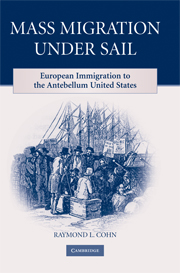Book contents
- Frontmatter
- Contents
- List of Tables and Figures
- Preface
- 1 A Unique Period for Immigration
- 2 The Onset and European Origins of Mass Immigration
- 3 The Jump in Immigrant Volume Around 1830
- 4 Push, Pull, and Other Factors in Antebellum Immigration
- 5 Who Were the Immigrants?
- 6 The Trip from Europe to the United States
- 7 The Immigrants in the United States
- 8 The Effects of Immigration on the United States
- 9 The End of Mass Migration Under Sail
- References
- Index
2 - The Onset and European Origins of Mass Immigration
Published online by Cambridge University Press: 30 June 2009
- Frontmatter
- Contents
- List of Tables and Figures
- Preface
- 1 A Unique Period for Immigration
- 2 The Onset and European Origins of Mass Immigration
- 3 The Jump in Immigrant Volume Around 1830
- 4 Push, Pull, and Other Factors in Antebellum Immigration
- 5 Who Were the Immigrants?
- 6 The Trip from Europe to the United States
- 7 The Immigrants in the United States
- 8 The Effects of Immigration on the United States
- 9 The End of Mass Migration Under Sail
- References
- Index
Summary
Critical to any economic analysis of antebellum immigration is data on the total number and geographic source of the European immigrants. In fact, the total number of immigrants who arrived during the antebellum period has been subject to a good deal of controversy. For example, Robert Swierenga, after comparing Dutch records to the U.S. records, concluded, “How nearly one of every two Dutch arrivals were omitted in the official U.S. immigration statistics is a mystery that demands further study. Should such underreporting apply to other immigrant groups the figures on total immigration in the nineteenth century would require drastic revision.” Actually, this chapter will show that the U.S. records for total immigration in most years are reasonably complete, although those for many individual countries are seriously flawed. One premise of this book is that mass immigration from Europe began during the antebellum period. Thus, an issue related to the total number of immigrant arrivals is when the sustained rise in the volume of immigration began, which is something also determined here. Finally, although the major source countries are well known, the geographic origins of the immigrants within these countries are often not clear. The evidence on both how many immigrants came from the major European source countries and where they came from within these countries is also investigated.
Determining the Beginning of Mass Migration
The existing estimates of non-slave immigration to the United States from 1700 to 1860 are shown in Table 2.1 and Figure 2.1.
- Type
- Chapter
- Information
- Mass Migration under SailEuropean Immigration to the Antebellum United States, pp. 14 - 46Publisher: Cambridge University PressPrint publication year: 2008

